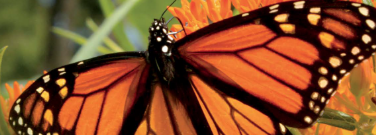Saying Goodbye to the Monarch Butterfly?

By Mark Miller
The black and orange markings of the monarch butterfly’s wings make it one of nature’s truly beautiful sights. But it’s an amazing insect for other reasons, too. As part of its migration to Mexico from the northern United States and southern Canada, the delicate butterflies can cover distances of nearly 3,000 miles.
Now, according to a story published by the World Wildlife Fund (WWF), these extraordinary creatures may be disappearing. They have been classified as “Endangered” by the International Union for Conservation of Nature (IUCN).
The Red List
The IUCN classifies species at risk of becoming extinct on its Red List, a comprehensive source about animals, fungi, and plant species, including information about population, range, habitat, and other criteria.
Based on WWF monitoring, the population of eastern migratory monarch butterflies has decreased over 80 percent. Reasons for this decline, according to the WWF, include the use of herbicides in the U.S. When monarch butterflies travel north in the spring, they lay their eggs only on milkweed plants, which become the food source for the beginning of their lives as caterpillars. Herbicides are causing a loss of milkweed and threatening the monarchs’ reproduction and survival. Another reason may be climate variations in North America that affect milkweed.
According to information from the Center for Biological Diversity, the monarchs’ decline, along with that of other insects, may negatively impact humans. The falling populations can influence food resources that rely on the activities of pollinators such as bees and butterflies.
A Living Symbol
Monarchs spend their winters in Mexico. They gather by the millions in the oyamel trees of the Monarch Butterfly Biosphere Reserve there. The WWF reports that they’ve become important symbols to local people, who believe the butterflies are the souls of ancestors that have passed away. Relatedly, the monarch’s arrival in early November coincides with Mexico’s Day of the Dead—a celebration of lost loved ones whose spirits are thought to return each year to visit their living families.
Back from the Brink
Like the souls of past ancestors, the monarch populations may also make a remarkable comeback. The WWF’s monarch butterfly expert, Eduardo Rendon-Salinas, seems to think so. “Cataloging the migratory monarch butterfly of North America to the IUCN Red List could be an opportunity for the species,” he says. “The governments of Canada, the U.S., and Mexico have the scientific basis to collaborate with conservation organizations, the private sector, and civil society in all the initiatives that seek to restore, conserve, and sustainably manage the ecosystems for the reproduction, migration, and overwintering of this emblematic species.”
Discussion Questions
- What is animal migration?
- What is the life cycle of butterflies?
- What effects can herbicides have on plant life?
